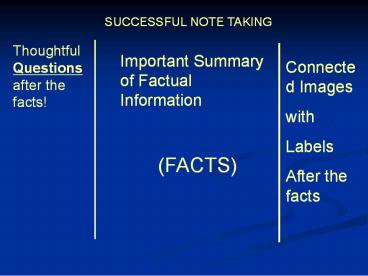Paleolithic and Neolithic Ages - PowerPoint PPT Presentation
1 / 16
Title:
Paleolithic and Neolithic Ages
Description:
SUCCESSFUL NOTE TAKING Thoughtful Questions after the facts! Important Summary of Factual Information (FACTS) Connected Images with Labels After the facts – PowerPoint PPT presentation
Number of Views:262
Avg rating:3.0/5.0
Title: Paleolithic and Neolithic Ages
1
SUCCESSFUL NOTE TAKING
Thoughtful Questions after the facts!
Important Summary of Factual Information (FACTS)?
Connected Images with Labels After the facts
2
Pneumonic Memory Device 1 Term Treaty of
Tordesillas Flashcard side 1
Flashcard side 2
3
Paleolithic and Neolithic Ages
4
Old Stone Age
- Paleolithic age lasted from 2 million B.C. E. to
10,000 B.C.E. - Evidence of the first Human ancestors was found
in Tanzania and Ethiopia. - In 1974 anthropologists found parts of a hominid
skeleton they named Lucy.
5
(No Transcript)
6
Survivors
- The earliest people were hunters and gatherers
- They survived by following their prey and did not
stay in one place too long. - As such they were nomadic and traveled in groups
of 20-30.
7
Life in the Stone Age
- The earliest humans
- used simple tools made out of stone,
- bone or wood
- learned to control fire
- developed spoken languages
- buried their dead
- believed that the world was full of
- spirits and these spirits were found
- in animals, the elements and nature
8
Cave Paintings, France and Spain
9
Neolithic Revolution
- The Neolithic revolution was very important
because people stopped hunting and gathering and
started farming. - It began in the East in Mesopotamia in the
Fertile Crescent - Why did it happen?
- Temperatures rose creating a warmer climate and
large animals started to disappear
10
(No Transcript)
11
Thrivers
- People in the Neolithic age rounded up animals
and penned them on grasslands or in enclosures. - This is called domestication.
- If people arent moving from place to place what
could change besides food source?
12
Results
- The population grew
- People in a village were given different jobs to
do - Trade was set-up between villages due to a
surplus in food - Councils were organized to govern the village
- Social classes formed as some people had more
money than others. - New technology
13
Pagan sites in England
14
How do you think it was built?
15
(No Transcript)
16
From the previous slides what historical themes
can we see developing?































